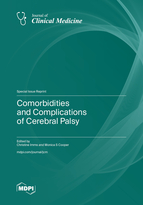Comorbidities and Complications of Cerebral Palsy
A special issue of Journal of Clinical Medicine (ISSN 2077-0383). This special issue belongs to the section "Clinical Neurology".
Deadline for manuscript submissions: closed (20 November 2022) | Viewed by 77309
Special Issue Editors
2. Murdoch Children’s Research Institute, Melbourne, VIC, Australia
Interests: occupational therapy; child-onset disability; participation; consumer-engaged research; longitudinal outcomes; intervention research; measurement
2. Murdoch Children’s Research Institute, Melbourne, VIC, Australia
3. Department of Neurodevelopment & Disability Royal Children's Hospital, Melbourne, Melbourne, Australia
Interests: cerebral palsy; neurodisability; drooling; bioethics
Special Issue Information
Dear Colleagues,
Cerebral palsy is the most common cause of physical disability in childhood that, despite evidence of falling prevalence in some Western countries, remains a global concern. Cerebral palsy is a clinical description, rather than a discrete diagnosis. Despite the aetiological heterogeneity, it is thought that many of the associated comorbidities and complications in cerebral palsy share more similarities than differences.
The aim of this Special Issue is to provide an overview of recent advances in the treatment of the associated comorbidities and complications of cerebral palsy. Increased prescription of technology means that we are treating some comorbidities of cerebral palsy earlier or even pre-emptively. Increased life expectancy, compared with 20 years ago, means that we are also seeing even later complications of cerebral palsy. There is increased access to intensive medical care at home, non-invasive ventilation and total parenteral nutrition. There is also the rise of the parent/carer voice and expectations. As society begins to discuss mental health more openly, we are also starting to recognise the significant two-way associations between disability and mental health. Ethical consultation may be warranted when harm with treatment exceeds benefit. As we prepare children with cerebral palsy for adulthood, there is more thought and discussion around issues such as pain, mental health, quality of life and independence. Researchers in the field of cerebral palsy are encouraged to submit original articles or reviews to this Special Issue (case reports and short reviews are not accepted), so that we can build our evidence base to guide decision making.
Prof. Dr. Christine Imms
Dr. Monica S. Cooper
Guest Editors
Manuscript Submission Information
Manuscripts should be submitted online at www.mdpi.com by registering and logging in to this website. Once you are registered, click here to go to the submission form. Manuscripts can be submitted until the deadline. All submissions that pass pre-check are peer-reviewed. Accepted papers will be published continuously in the journal (as soon as accepted) and will be listed together on the special issue website. Research articles, review articles as well as short communications are invited. For planned papers, a title and short abstract (about 100 words) can be sent to the Editorial Office for announcement on this website.
Submitted manuscripts should not have been published previously, nor be under consideration for publication elsewhere (except conference proceedings papers). All manuscripts are thoroughly refereed through a single-blind peer-review process. A guide for authors and other relevant information for submission of manuscripts is available on the Instructions for Authors page. Journal of Clinical Medicine is an international peer-reviewed open access semimonthly journal published by MDPI.
Please visit the Instructions for Authors page before submitting a manuscript. The Article Processing Charge (APC) for publication in this open access journal is 2600 CHF (Swiss Francs). Submitted papers should be well formatted and use good English. Authors may use MDPI's English editing service prior to publication or during author revisions.
Keywords
- cerebral palsy
- family factors
- physical health
- mental health
- prevention (primary and secondary)
- interventions
- management
- quality of life
Benefits of Publishing in a Special Issue
- Ease of navigation: Grouping papers by topic helps scholars navigate broad scope journals more efficiently.
- Greater discoverability: Special Issues support the reach and impact of scientific research. Articles in Special Issues are more discoverable and cited more frequently.
- Expansion of research network: Special Issues facilitate connections among authors, fostering scientific collaborations.
- External promotion: Articles in Special Issues are often promoted through the journal's social media, increasing their visibility.
- Reprint: MDPI Books provides the opportunity to republish successful Special Issues in book format, both online and in print.
Further information on MDPI's Special Issue policies can be found here.







